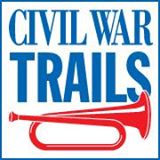By Linda Cicoira — Two narrative signs are being planned for Onancock and Parksley that will help educate local residents and visitors about Civil War activities in the area.
“Just because there were no major battles, the Shore holds a lot of significance in telling the history of the Civil War,” said Cara Burton, director of the Eastern Shore Public Library, who is overseeing the Shore program.
“We are still figuring out exact locations,” she said. “These signs are designed for walk-up reading and include photographs. Interestingly, no one has been able to produce a non-portrait Civil War photograph depicting encampment or other activity on the Shore. If anyone has one, the library would appreciate being able to scan a copy for possible use in this project,” Burton added.
The Onancock sign “will launch the Civil War Trail program on the Eastern Shore of Virginia, which will be of great long term benefit for historic tourism to the town,” Burton wrote in a letter to town officials there. “People from around the world seek out Civil War sites and the marketing the CWT program is an efficient way to tell millions to visit Onancock.”
The project includes directional “bugle” signs on Route 13, that will alert visitors and “encourage them to explore these wonderful towns,” Burton said.
The plan is to put the signs on the grassy corner by the farmer’s market in Onancock and at the ESVA Heritage Center at the new library in Parksley. Civil War Trails Inc. is a nonprofit organization founded in 1994 and offering more than 1,550 sites in Virginia, Maryland, West Virginia, North Carolina, and Tennessee. There are more than 800 partners including state tourism offices, chambers, businesses, and museums. Guide brochures are distributed domestically and internationally. The group contends travelers who visit Civil War sites stay longer and spend more than average travelers.
“Our average overnight guest stays 50% longer than other travelers averaging 2-5 days,” CWT reported. More than 30% spent between $250 and $750 during their trip with 20% spending more than $1,000. “Our average guest spent 25% of their budget on food and beverage and 33% on lodgings. More than 75% of our guests also enjoyed state parks, beach, and camping. More than 30% of our guests also enjoyed fine dining, wineries, and breweries. We promoted Civil War Trails at 23 consumer shows resulting in several thousand leads. We have 84 projects underway including new sites, content updates, and maintenance.
A thesis submitted to Virginia Tech by Matthew Ostergaard Krogh in 2006 and found at
states, “the Shore underwent important military duress in the form of raids, skirmishes, and tactical maneuvers. The reason these clashes were important is because they helped shape Union protocol in other campaigns. The campaign for the Shore also stands out as an example of a fairly bloodless fight. This exemplifies the Union’s true capabilities in the first year of the Civil War which were overshadowed by glorious Confederate victories. This thesis also argues that the Atlantic and Chesapeake, which virtually surrounded the Shore, played an important role in the way it fought the war. Rather than detract from its significance by isolating it, these waters added to its role. Southern and Northern sympathizers found ways to aid the South and the North via the Chesapeake Bay and the Atlantic Ocean. Lastly, this survey argues that the Shore underwent an almost unprecedented occupation by Union forces which created a peaceful, yet resentful enclave of Southern territory. The Eastern Shore of Virginia, isolated and alone, found itself far away from military action after 1861 although it bordered the most important region of the war. Yet from 1862 to 1865 the Shore became engulfed with a war of its own.”
The thesis names several books on the subject: “The Virginia Eastern Shore in the War of 3 Secession and in the Reconstruction Period” by James Mears, “Chesapeake Bay in the Civil War,” by Eric Mills, “Revival’s Children: A Religious History of the Eastern Shore” and “True Tales of the Eastern Shore,” by Kirk Mariner, and “Drummondtown: A One Horse Town,” by L. Floyd Nock.
“Nathaniel J. W. LeCato, an officer of the 39th Virginia, wrote a satiric autobiographical novel,” the thesis states. “‘Tom Burton; or, the Days of ‘61’ told his story of the Union invasion of the Shore. Union General John A. Dix also wrote his memoirs, which discussed the invasion as well. Gen. Lockwood’s papers exist in manuscript form in the National Archives.”



